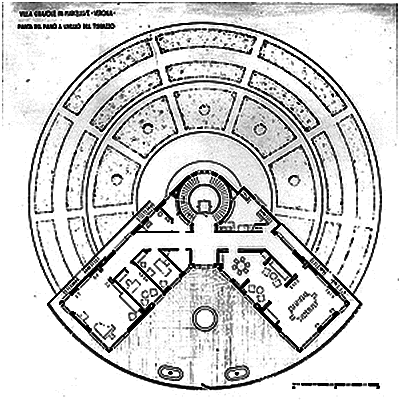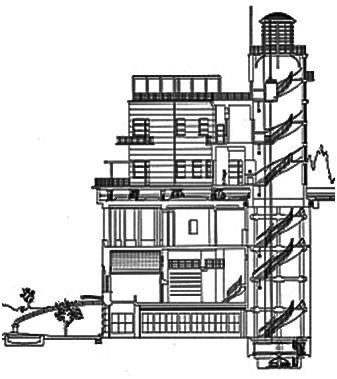The Villa Girasole
Today, UH architecture professor, Dietmar Froehlich tells about a rotating house. The University of Houston presents this series about the machines that make our civilization run, and the people whose ingenuity created them.
Everyone enjoys riding a merry-go-round. How about indulging that joy in your house? The idea of moving buildings surfaced in the late 19th century. Technology had made ideas about so-called kinetic architecture feasible. The first such buildings had only parts that moved. Three rooms rode on a turntable on one wall of a 1924 German design. As time came for sleeping, dining, or just living, different rooms rotated into a central area. The house became a kind of stage set!

Il Girasole - First Floor / Wings: music room, dining, etc.
Whole buildings that rotated presented a bigger engineering task. Occupants of a revolving house could follow the sun’s path and enjoy a panoramic view of the land.

Gears and mechanical revolving system
The Villa Girasole in a town near Verona is a great example: It was the brainchild of Italian engineer Angelo Invernizzi. Invernizzi worked for the railway in Padua, where he met the same technology that served his revolving house.

Angelo Invernizzi (1884-1958) with wife Lina in 1956
Girasole means “Sunflower” and the villa was completed after four years in 1935. Like a “Sunflower” it turned according to the sun’s position. Two-story wings extend from a central spine that house a staircase and an elevator. The wings hold the various rooms of the residence and sit on a drum-like base. The base holds the roller-bearings below the central column.

Gears and mechanical revolving system
The machinery and gear-work are based on railroad turntables. It all moves on adapted railcar wheel mounts at about nine inches per minute. When you see fifteen visible sets of wheels under the wings you know the villa moves.

Wheels and tracks on terrace
The two residential wings embrace a terrace on top of the central cylinder. The first floor, the “day zone”, holds public spaces for living, dining and entertaining. The upper floor is for private rooms. All the main rooms have a view of the terrace. It’s the beloved focal point of the house, and the preferred space for outdoor entertainment. A three-button panel in the foyer controls the villa’s rotation. From the hillside you have a magnificent view of the surrounding vineyards.

View from terrace towards central tower
The Girasole also served as a laboratory for new construction methods and building materials. The interior reflects the 1930s transition from Art Deco to Modernism; the exterior speaks to the fascination with machines. The V-shaped wings are clad in aluminum panels. Their relative flexibility solved some of the problems caused by rotation.

Under construction - 1931-35
And, as we climb the spiral staircase in the central tower, we feel the structure go from railroad massiveness at the bottom to the buoyancy of the light-filled wings above.

The Villa Girasole owes to the prevailing Zeitgeist as well as the imagination of its designer: it espoused technology, machines and a belief in progress. The “Sunflower” — the Girasole — and Angelo Invernizzi are witness to the way creativity transcends disciplines. The villa defies architectural classification. Here’s a unique result of imagination and a determination to fulfill an architectural dream.
I’m Dietmar Froehlich, at the University of Houston, where we’re interested in the way inventive minds work.
(Theme music)
Il girasole: una casa vicino a Verona. 1995, Switzerland.
35 mm, 17 min. Color.
Dir.: Marcel Meili, Christoph Schaub
Kenneth Frampton and Aurelio Galfetti. INVERNIZZI. Villa Girasole: The Revolving House. (Mendrisio: Accademia di Arch. Mendrisio, 2006).
LTL Architects. "Mechanical Panoramas: Invernizzi's Il Girasole." In AA files 55 (London: Architectural Association, Summer 2007.
Chad Randl. Revolving Architecture. A History of Buildings that Rotate, Swivel, and Pivot. (New York: Princeton Architectural Press, 2008).
Angelo Invernizzi and A. Fagiuoli. Villa Girasole in Marcellise in Architettura anno XV, 1935.